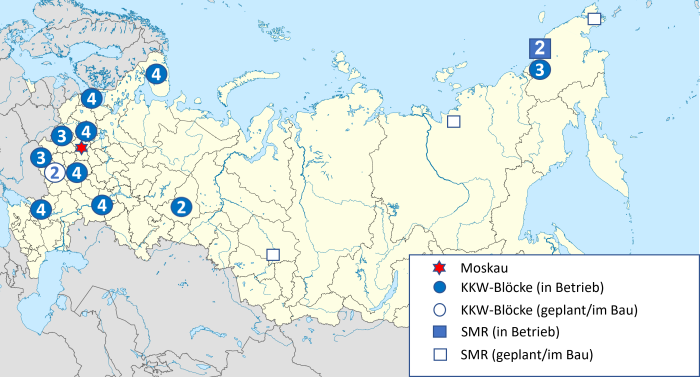Nuclear energy in Russia (16.08.2023)
• Russia is actively engaged in the further development of nuclear power; two conventional SMRs are already in operation, and one lead-cooled SMR is currently under construction.
• The country exports its reactor technology to a number of countries; it is also a world leader in uranium enrichment.
Status quo of power generation
The 37 reactors in operation are mainly water-cooled and water-moderated pressurized water reactors, so-called VVERs, with an electrical output of 440, 1,000 or 1,200 MW. In addition, eleven graphite-moderated RBMKs, two sodium-cooled fast breeders and two SMR units have been operating since the 1970s and 1980s on the "floating" NPP Akademik Lomonosov, which supplies the remote city of Pewek with energy; these are standard reactors of the type used in the icebreaker fleet.
Political and legal framework
The basis for energy policy and energy industry development in Russia is the energy strategy for the period up to 2030 confirmed by the government in November 2009, which was revised and updated in 2015 and 2020 with an outlook to 2035 in line with changes on the world market and the development of the Russian energy industry.
The Russian energy strategy stipulates as goals the effective use of natural energy resources and the maximisation of the potential of the energy sector. For the year 2030, a reduction of energy intensity by 56 percent (compared to 2005) is targeted. The share of nuclear power in the electricity mix is to remain at about the same level over the next decades. According to the strategy until 2035, the NPP units to be decommissioned are to be replaced by new plants and, if there is a need, NPPs are to be built at new sites.
Both the RBMK and VVER-440 reactors were designed to operate for 30 years; however, the lifetimes of these reactors have been extended by 15 years, allowing them to operate for 45 years. There are plans to extend the operating life to 60 years in some cases, while the VVER-1000 reactors are planned to operate for up to 50 years.
The construction and operation of NPPs is the responsibility of Rosatom, the nuclear agency directly under the Russian government, which is also responsible for exporting Russian reactor technology abroad as well as for the military nuclear power sector. In March 2021, Rosatom declared that the share of nuclear power in the electricity mix should grow to 25 % by 2045, which would require the commissioning of 24 units.
Current plans and projects
Large NPPs. In fact, however, only two units are currently being built: Since April 2018, the Kursk-II NPP has been under construction in the Kursk Oblast, where Units 1 and 2 are the prototype units of the VVER-TOI construction line. These are to replace the neighbouring plant, the Kursk NPP. Commissioning of the first unit was originally planned for 2022 but is currently expected for 2024/2025.

SMR. Another new plant is being built in the closed town of Seversk in Tomsk Oblast: the BREST-300 is a lead-cooled fast breeder reactor that is scheduled to go into operation in 2026. In addition, the two 32-MW SMRs mentioned at the beginning are already operating in Russia at the Akademik Lomonosov NPP.
In April 2021, Russia announced a new energy supply project with floating NPPs. The project envisages the construction of five upgraded floating NPPs with RITM-200 reactors to supply energy to the Baim gold and copper mine in Chukotka from 2027. In 2028, the first "land-based" SMR, based on the RITM-200N concept, is to be constructed and commissioned at the Ust-Kuiga site (Yakutia). In April 2023, a siting licence was granted for a first NPP with a land-based SMR of the RITM-200N type. Both SMR plants are already under construction.
Nuclear icebreakers and cargo vessels. Nuclear propulsion has proven to be technically and economically indispensable in the Russian Arctic, as the operating conditions exceed the capabilities of conventional icebreakers. The power required to break ice that is several metres thick and the difficulties of refuelling other types of vessels are important factors. The fleet is operated by Atomflot, a division of Rosatom.
Seven icebreakers are currently in operation and three more are under construction. The reactor used here is the RITM-200, which is also used to build the land-based SMRs. In addition to icebreakers, Russia also has cargo and container vessels with nuclear propulsion.
Activities abroad. In addition to domestic projects, the expansive orientation of the Russian nuclear industry needs to be emphasised. Russia is currently building or planning NPPs in Egypt, Bangladesh, Belarus, China, India, Turkey and Hungary; a planned project in Finland was cancelled due to the invasion of Ukraine. In addition, a large number of reactors of Russian or Soviet design are still in operation in Eastern Europe.
Research reactors
According to the IAEA, 52 Russian research reactors are currently in operation in Russia, and three more are being built - nowhere else are there as many research reactors in operation. If you add the plants that have been shut down and partly dismantled, the number is well over 100. However, a large number of these plants are also used for military nuclear power exploitation.
Uranium enrichment and mining
Russia plays a major role in uranium mining and processing: although Russia produces only 6% of the world's uranium (2020), over 20% of conversion and over 40% of the world's uranium enrichment is carried out in Russia. Since the beginning of the invasion of Ukraine, Western countries have been trying to reduce this dependence.
